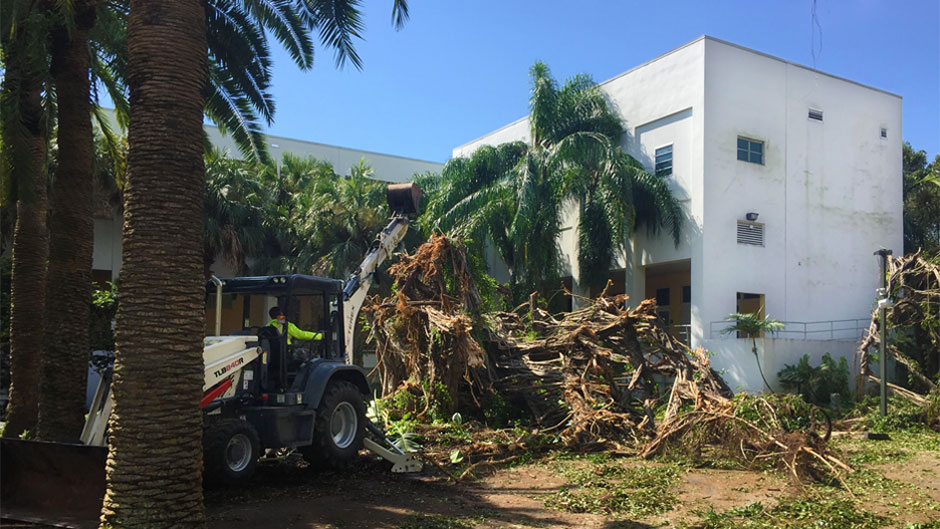The color-coded debris removal map on display in the University of Miami’s Emergency Operations Center tells the remarkable story of resilience and progress underway since Hurricane Irma twisted the lush landscape of the Coral Gables campus into a widespread tangle of vegetation.
As of Thursday, September 14, the map showed that crews who spent three days chopping, grinding, and hauling scores of beloved trees that toppled in the 100 mph winds had cleared all of the debris impeding access to recovery efforts. Once it became safe for crews to traverse across campus, they conducted a room-by-room assessment of more than 125 buildings and began vital repairs.
“We could not have done it without our dedicated staff and numerous vendors who are working shoulder to shoulder,” said Larry Marbert, vice president for real estate and facilities, of the mammoth undertaking. “We’ve turned the corner and we’re now in full recovery mode.”
Like the rest of Southeast Florida, UM was lucky. It was spared a direct hit from a top-of-the chart category 5 that menaced the state for days. But the 24-hour pummeling from Irma’s fringes left a cascade of challenges in its wake.
The fallen trees not only made every external and internal road on the Coral Gables campus impassable, they also took down the University’s power lines and damaged its infrastructure, including sanitary sewer, telecommunications, and irrigation systems.
“Honestly, when I saw it, I was a bit emotional,” said Eli Stephan, of Facilities Work Control, who kept the EOC’s over-burdened generator running during Irma’s approach by continuously going outside to feed it fuel.
But there was no time for emotion. Like all of the University’s first responders, Stephan arrived on campus at daybreak on Monday, ensuring the first crews to arrive could begin their work.
One week earlier, with Hurricane Irma still more than four days away, University officials moved quickly and decisively to safeguard the 4,300 students on campus, announcing on Tuesday, September 5, that classes would be cancelled beginning on the following day until further notice.
“Our decision was to allow as much opportunity as possible to get students to leave the Miami area and then everything possible to get those students who couldn’t leave prepared,” said Patricia A. Whitely, vice president for student affairs. “We got great support from President Frenk, cabinet members, and Emergency Management personnel—it was absolutely a team effort.”
The University arranged for shuttles to transport students to Miami International and Ft. Lauderdale-Hollywood International airports and to ferry students who could not leave town to Publix and CVS to stock up on water, batteries, and any necessary medications.
By Thursday, September 14, power had been restored to most buildings on the Coral Gables campus. With fewer trees and buildings, as well as less damage, other UM campuses fared better. The Miller School of Medicine and Rosenstiel School of Marine and Atmospheric Science lost power only briefly. On Wednesday, September 13, the Rosenstiel School’s CSTARS facility resumed operations, and the University of Miami Health System and Miller School of Medicine resumed clinical operations.
“Safety before, during, and after the storm remains our number one priority,” said UM President Julio Frenk. “We are bringing our students, faculty, staff, and patients back and resuming full operations in an orderly, organized, and safe manner.”

